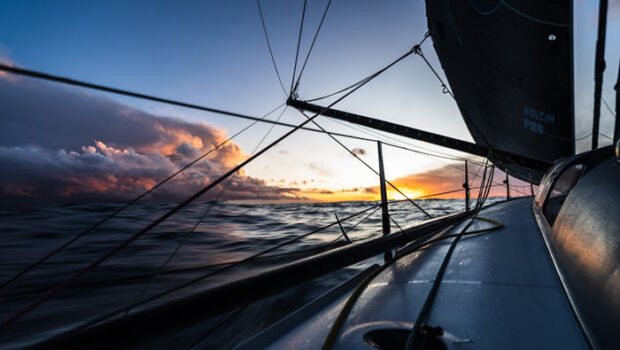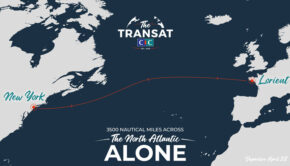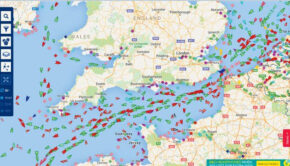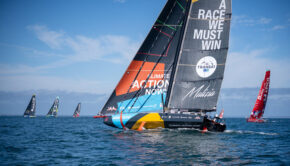Collisions at sea with marine mammals
Published on October 20th, 2023
Over the past 10 years, as boats of all kinds have got faster, the number and severity of collisions at sea with marine mammals – especially whales – and with debris in the water has steadily increased.
In the case of whales, these collisions, especially with boats traveling at over 10 knots (and up to 35 knots), often result in serious injury or death. They can also result in extensive damage to a boat which may be forced to retire from a race as a result.
The IMOCA Class has been leading the effort to mitigate these events in a collaborative effort led by Claire Vayer, Sustainability and Partnerships Manager for the Class, working alongside Damian Foxall, Sustainability Program Manager with the US-based 11th Hour Racing Team which is helping to fund the project.
There are a number of other stakeholders involved, including The Ocean Race and World Sailing, and together they make up the Marine Mammal Advisory Group (MMAG).
One of the first fruits of this effort is new Hazard Button technology which has been incorporated in the latest version of the Adrena and Expedition Marine navigation software systems used by all IMOCA skippers.
This will be present on about one third of the IMOCA fleet in the Transat Jacques Vabre in boats equipped with the latest version of the software. The idea is for skippers to be able to record the location, nature, and timing of collisions, and then automatically inform the race director and other boats in the race.
“It is not about detecting mammals or other objects in the water using technology; this is about when you hit something, you press the Hazard Button and information is sent to the race director and to the other sailors,” explained Vayer. “We launched it for The Ocean Race but that was like a pre-test or beta version. For the Transat Jacques Vabre, we are going to launch the project officially.”
Foxall says this system will contribute to the global record of collisions with marine mammals at sea and over time will enable all users of the sea, not only race organizations, to avoid areas known to be home to large numbers of mammals or areas through which they migrate.
“It’s not only about compiling this data, it’s about understanding where it is happening and how it is happening,” says Foxall. “You can’t take mitigation actions until you’ve got the information to work with. But with the right information we can define where the risks are and therefore where we can sail and where we should definitely not sail.”
Yann Eliès, who is racing in the TJV alongside Yoann Richomme on board Paprec Arkéa, is an enthusiastic supporter of the Hazard Button innovation which will also be used in other classes in the race.
“If it works properly and if everybody tries to use it, I think it is the future for everybody because we can share all the information we have with the other boats and with the race director,” commented Eliès, who will serve as assistant race director for the next Vendée Globe with responsibility for this area.
“And for the race director, it is important because he has news from the boats and an incident can lead to new information and we can collect it for the future,” Eliès added. “I think it is very important because all the guys who are doing offshore racing have to do something for the mammals because the boats are going faster.”
Eliès is quite open about the fact that the general public will expect IMOCA to take this sort of action. “If we are not ready to do this, the public will probably not understand and will be very tough with us,” he said.
The Hazard Button is not the only avenue being pursued by the MMAG. Alongside it, the effort to use technology to detect objects in the sea ahead of fast moving boats is also continuing. Right now, around 25 IMOCAs carry an infra-red camera at the top of the mast which detects floating objects in the water, but it is difficult for it to “see” a whale, especially in rough weather.
On the solo Retour à La Base race, which sets sail from Martinique for Lorient in late November, two yachts – Sam Goodchild’s For the Planet and Jérémie Beyou’s Charal – will be equipped with an automatic collision avoidance system for its first test.
This is known as EXOS 2024 and it utilizes artificial vision, multi-sensor fusion and the use of the auto-pilot. Led by Pixel sur Mer in collaboration with Sea.Ai and ENSTA Bretagne, this system aims to improve object detection and to provide automatic obstacle avoidance.
“The complete system will merge data from various detection sensors and will be able to send an instruction to the auto-pilot to help the boat avoid a collision,” explained Vayer. “But for the Retour à La Base, only the data fusion system, along with information sent to the sailor, will be operational and then it will be the sailors’ decision as to how they react. But in the end, the aim is for it to act directly on the auto-pilot.”
Vayer said the goal is for EXOS 2024 to be available in its first version to entrants in the next Vendée Globe, and then to be included as a mandatory requirement on all boats by the following race in 2028.
Foxall, meanwhile, says this Transat Jacques Vabre marks a big step in changing the approach by sailors and race directors to the issue of collisions at sea. “The goal of the MMAG is to make people aware, to change the conversation and really make this Hazard Button protocol best practice across the system,” he said.
“So if you hit something now, it is not about keeping quiet and not telling anyone; it’s about reporting it in a way in which you are comfortable and doing so anonymously if you need to.
“By creating this safety net, we are all safer not just immediately, but also in the future because the more detail we get the more well-informed we are about areas of high incidences of strikes and areas of bio-diversity.”
Source: Ed Gorman, IMOCA









 We’ll keep your information safe.
We’ll keep your information safe.